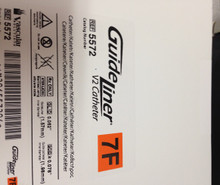
The GBAT technique is a modification of the Balloon Assisted Tracking (BAT) technique, a method described to advance guide catheters through radial arteries with extreme bends and loops. The more distal the GuideLiner is delivered the easier the procedure becomes. It works both by increasing active support and by traversing difficult segments and shortening the distance required to deliver stents. GuideLiner catheter has become a popular and extremely useful tool in treatment of difficult coronary anatomy. Several techniques are available to operators to help improve success rates in complex PCI procedures. Despite improvements in-stent profile, stent delivery can be challenging in certain lesions. With studies showing excellent outcomes with drug-eluting stents, an increasing number of difficult lesions are treated by PCI. This allowed the GuideLiner to pass the proximal stented segment and allow for postdilation of the stented segmented ( Figure 5(c)). Next we advanced a 2.0 × 15 mm compliant balloon halfway protruding from the GuideLiner and inflated the balloon at 8 atm ( Figure 5(b)). We also had difficulty advancing the GuideLiner past the proximal stented segment.

After stent deployment we could not deliver our 3.5 noncompliant balloon for postdilatation. Due to vessel tortuosity we used a GuideLiner to assist in-stent delivery.

The lesion was crossed with a workhorse wire and predilated with 2.0 compliant balloon. There was brisk collateral filling from the RCA. The angiogram showed a hazy lesion within the mid RCA as the likely culprit with moderate ISR in the proximal vessel ( Figure 5(a)). He has had previous history of CAD with PCI to the proximal to mid RCA with bare metal stents in 2002. The RCA was stented distal to the ostium with a total of five drug-eluting stents.Ī 72-year-old male presented to hospital with retrosternal chest pain and elevated biomarkers and was referred for inpatient coronary angiography. The GuideLiner was easily advanced to the distal RCA ( Figure 2(b)) facilitating stent delivery and procedural success ( Figure 2(c)). Using GBAT technique, a 2.0 × 15 m compliant balloon was inflated protruding halfway out of the GuideLiner at 8 atm. The distal anchoring technique with a 2.5 NC balloon was also attempted but was unsuccessful. A 6 French GuideLiner was used but would not advance beyond the ostium of the RCA. Despite predilatation with a 2.0 and a 2.5 noncompliant balloon at high pressure, stent delivery proved quite difficult. The RCA was diffusely diseased with stenosis extending from the distal RCA to the ostium ( Figure 2(a)). The lesion was crossed easily with a Pilot 50 wire restoring distal flow. Coronary angiography showed an occluded mid right coronary artery (RCA) with brisk collaterals from the left anterior descending artery (LAD). The main process of GBAT technique involves the following.Ī 72-year-old male presented with a non-ST elevation myocardial infarction (NSTEMI). The “GuideLiner Balloon Assisted Tracking” (GBAT) is relatively easy to perform and has a low risk of complications. We describe a novel technique that would facilitate delivery of the GuideLiner catheter across difficult segments and increase procedural success rates. This sometimes can be difficult through tortuous and calcified vessels or through previously stented segments.

To increase success rates, the GuideLiner should be delivered as close as possible to, and sometimes across, the target coronary lesion. Stent delivery failure occurs in up to 5% of all PCI cases, which can result in suboptimal revascularization and has been associated with increased complication rates The GuideLiner catheter, a mother-and-child catheter that can be delivered deep into the coronary artery, provides excellent support and facilitates stent delivery. Despite improvements in-stent profile, stent delivery can still be problematic in complex coronary anatomy. With the advent of drug-eluting stents, an increasing number of difficult lesions are treated by percutaneous intervention (PCI).


 0 kommentar(er)
0 kommentar(er)
